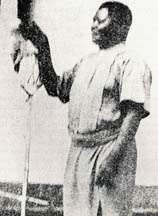Classic DACB Collection
All articles created or submitted in the first twenty years of the project, from 1995 to 2015.Kimbangu, Simon (B)

Prophet Simon Kimbangu was the most important of the prophet founders in the independent church movement. The Church of Jesus Christ on Earth by the Prophet Simon Kimbangu is one of the largest of such communities and was the first both to establish a theological school and to be admitted to the World Council of Churches. Little of this was foreshadowed by Kimbangu’s life, however, most of which was endured in prison.
The outlines of his life are simple. Although Kimbangu’s father was a traditional religious leader, Simon was converted by the Baptist Missionary Society in 1915. He worked for several years as a catechist, a religious teacher who prepares candidates for baptism, and then had a vision in which God gave him a divine commission to preach and heal. To escape the divine command, he fled to Léopoldville, the capital of the Belgian Congo, where he did migrant work. In 1921 he cured a sick woman and returned to the Lower Congo region to preach. This mission, which lasted only six months, had astounding effects. He drew crowds, to the extent that workers left the plantations to hear him speak and hospital beds were emptied of those hoping for cures. The word spread that an ngunza (prophet) and mvuluzi (apostle, messiah) was among the Congo people. Kimbangu cured the sick and was said to raise the dead. His village, Nkamba, was renamed New Jerusalem. The mission became a mass movement and began to take on nationalist overtones, disturbing both the Baptists and the Belgian colonial authorities. His healing ministry had a powerful impact, as followers proclaimed his cures and miracles. In all this were echoes of the messianism of KIMPA Vita two centuries earlier.
Kimbangu employed Christian symbolism, seeing himself as a Christ figure. He appointed 12 apostles to assist him and laid down three moral rules: the abolition of all traditional religious symbols, the eradication of erotic dancing and the destruction of dance drums, and the end of polygamy. He opposed witchcraft and sorcery. To the shock of the missionaries, who had worked toward these goals for years with little result, Kimbangu’s disciples conformed to his rules without a murmur.
Africans often believed that the missionaries held back the secrets of Christianity that were the source of European power and wealth, and therefore Kimbangu’s leadership provided a way to unlock these secrets by using a prophet who had talked to God. Kimbangu identified God with nzambi, the Congo supreme being, and preached God’s closeness to his people.
The movement also fed on anti-European feeling and thus aroused the Belgian government’s concern. Prodded by missionaries, especially the Catholics, the government panicked. Machine guns were posted in the capital in expectation of an African uprising. The first attempt to take Kimbangu failed when he slipped away from a rally, resulting in stories of his miracle-working. Kimbangu turned himself in to authorities, was charged with sedition, and was sentenced to death. King Albert I commuted the sentence to life imprisonment with 120 lashes, and Kimbangu was sent a thousand miles away, where he died after 30 years in isolation from his followers.
If the Belgians thought that this would silence the movement, they were mistaken. During his trial, Kimbangu assumed the stance of the martyred Christ during his passion; in detention his figure took on iconic proportions. Even traditional Christians admired his acceptance of his fate, his obvious prayerful piety, and the evidence of his deep personal holiness. Although he could not preach in prison, his demeanor was patient and loving, and he shared his meager food rations with other prisoners. His followers begged him to use his miraculous powers to escape but continued to build his movement without him. The Belgians cracked down on Kimbanguists, but the church went underground, led by Kimbangu’s son, Joseph DIANGIENDA. Several related sects soon appeared, all acknowledging Kimbangu as their spiritual father. Kimbangu also became a symbol of Congolese nationalism, and Kimbanguism fostered group cohesion. By diminishing the power of magic and witchcraft, it helped to develop mutual trust and community. It also challenged the authority of the local chiefs, who were seen - quite rightly - as the lackeys of the Belgian authorities.
A church council was established in 1956, five years after Kimbangu’s death, and his three sons, led by Diangienda, took over. In 1991, President MOBUTU Sese Seko, who had legalized the church, posthumously amnestied Kimbangu and awarded him the National Order of the Leopard.
Norbert C. Brockman
Bibliography
Dictionary of African Biography. Algonac, MI, and New York: Reference Publications, vol. 1, 1977; vol. 2, 1979.
Lipschutz, Mark R., and R. Kent Rasmussen. Dictionary of African Historical Biography. 2nd edition. Berkeley: University of California Press, 1986.
Ewechue, Ralph (ed.). Makers of Modern Africa. 2nd edition. London: Africa Books, 1991.
Additional Reading: Martin, Marie-Louise. Kimbangu: An African Prophet and His Church (1976).
This article is reproduced, with permission, from An African Biographical Dictionary, copyright © 1994, edited by Norbert C. Brockman, Santa Barbara, California. All rights reserved.
External links
Encyclopaedia Britannica (complete articles): Kimbangu, Simon, Kimbanguist Church



